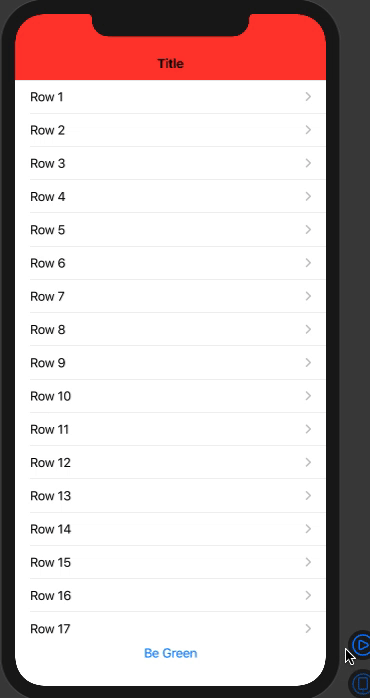

我正在尝试在我的应用程序中实现一个颜色主题选择器。 我试图克服的最后一个障碍是动态改变我的UinavigationBar的颜色。 目前,我改变颜色的功能确实起作用,但只有当应用程序已经从关闭状态重新启动时才会生效。
我的根视图控制器按如下方式设置UINavigationBar的初始状态:
struct MyRootView: View {
init() {
UINavigationBar.appearance().backgroundColor = getPreferredThemeColour()
UINavigationBar.appearance().largeTitleTextAttributes = [
.foregroundColor: UIColor.white]
}
var body: some View {
...
getPreferredThemeColour()只是从UserDefaults返回所需的UIColour
我的主题选择器有一些按钮可以改变颜色属性,如下所示:
Button(action: {
UserDefaults.standard.set(UIColor.blue, forKey: "theme")
UINavigationBar.appearance().backgroundColor = UIColor.blue }) {
我似乎找不到任何方法来“即时”刷新UINavigationBar以反映所做的更改。 应用程序总是需要重新启动。
如有任何帮助,我们将不胜感激!!!! 谢谢。
应用于在外观本身之后创建的实例的外观。 因此解决方案是在外观更改后重新创建NavigationView。
这里是一个方法的工作演示。 使用Xcode 11.4/iOS 13.4进行测试

struct DemoNavigationBarColor: View {
@State private var force = UUID()
init() {
let navBarAppearance = UINavigationBarAppearance()
navBarAppearance.configureWithOpaqueBackground()
navBarAppearance.backgroundColor = UIColor.systemRed
UINavigationBar.appearance().standardAppearance = navBarAppearance
}
var body: some View {
VStack {
NavigationView(){
List(1 ... 20, id: \.self) { item in
NavigationLink(destination:
Text("Details \(item)")
) {
Text("Row \(item)")
}
}
.navigationBarTitle("Title", displayMode: .inline)
}.id(force) // recreate NavigationView
Button("Be Green") {
UINavigationBar.appearance().standardAppearance.backgroundColor = UIColor.systemGreen
self.force = UUID() // << here !!
}
}
}
}